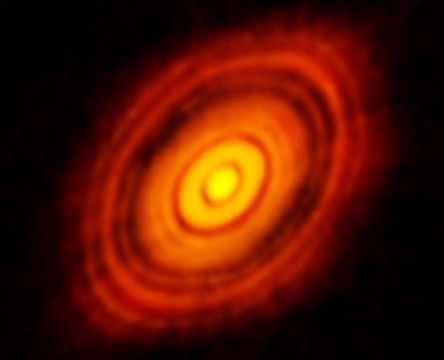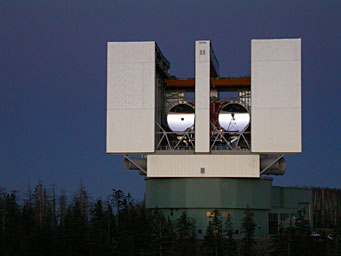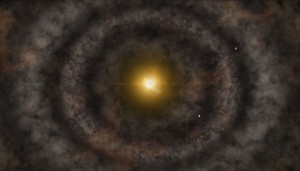When astronomers went searching for the planets that must exist around HL Tau, they came up empty — and future searches may not fare much better.

ALMA (NRAO/ESO/NAOJ) / C. Brogan / B. Saxton
Do you remember this bull’s eye that the Atacama Large Millimeter/submillimeter Array (ALMA) unveiled almost a year ago? This striking image revealed planetary genesis around the young star HL Tauri: gaps in its planetary disk that signify new planets clearing their path through the dust and gas.
But as two recent papers show, those planets might lie out of our observational reach.
Minding the Gaps
The bull’s-eye disk around HL Tau has three distinct, ringlike gaps, at about 15, 30, and 70 astronomical units (a.u., the distance between Earth and the Sun) from the star. Though the star is only about 500 light-years from Earth, it shines at a dim magnitude 14 due to the cocoon of gas that surrounds it. But ALMA was able to peer through this screen by looking at longer wavelengths with higher resolution than ever before, thereby uncovering the disk. And at the first sight of the disk’s wide gaps, astronomers anticipated detecting forming planets inside the rings.

LBT Observatory / Aaron Ceranski
So Leonardo Testi (European Southern Observatory, Germany) and colleagues set out to find them. Using the Large Binocular Telescope in Arizona, the team peered deep inside the debris disk surrounding HL Tau, searching for the infrared glow that would signify a young, hot planet forming there.
A starshade, called a coronagraph, blotted out the star’s brilliant radiation — kind of like you would block out the Sun’s glare by placing your hand over its disk in the sky — which is far more a problem in the infrared than at the submillimeter wavelengths that ALMA sees. Adaptive optics helped sort out any starlight that leaked through, paving the way for planet detection. As a consequence of the coronagraph, though, the 20-a.u. gap was blotted out and the 30-a.u. gap was barely visible. So Testi’s team focused on the third gap at around 70 a.u.
As it turns out, the third gap is ideal not just for practicality, but also because this is the region of the disk where gravitational instabilities might most easily cause clumps of dust and gas to clump together and collapse into planets. In a system less than 1 million years old, especially at distances 70 a.u. away from the parent star, gravitational instabilities are the most likely pathway for planet formation. Other ideas, such as the core-accretion scenario, where a small rocky core forms first and then collects a gaseous envelope, take too long.
But even though the simulations said planets should form there, and the gaps gave testament to their presence, Testi’s team found nothing.
Honey, I Shrunk the Planets

NSF / A. Khan
By estimating how much infrared glow should come from planets of various sizes in a young system, Testi and colleagues figured out that they should have been able to detect a planet with at least 10 to 15 times the mass of Jupiter. And the gaps are wide enough that they would require a planet with at least that amount of mass to clear out both the dust and the gas in the disk.
Yet perhaps the planets are smaller. In a recent simulation of HL Tau, Giovanni Dipierro (University of Milan, Italy, and Monash University, Australia) and colleagues found that planets with a few tenths of Jupiter’s mass could reproduce the disk gaps — but only if they clear away the dust and not the gas.
The gaps in the ALMA observations look completely clear, but that’s because we’re seeing it at millimeter wavelengths, which highlight the cool dust of the disk and not its somewhat hotter gas. While ALMA did image the disk’s gas as well, it’s hard to see it amidst the larger gaseous cocoon that enshrouds the whole system. To pick out the gas that’s in the disk rather than the cocoon would require a special observational technique.
With or without gas observations, planets are really the only plausible explanation for the disk gaps, says Alan Boss (Carnegie Institution for Science). “There is no alternative that I can conceive.”
But will ALMA or other telescopes be able to find these planets? Testi notes that in order to find smaller planets 70 a.u. from HL Tau, astronomers will need to improve the contrast in their infrared imaging by 3 to 4 magnitudes at only 0.5 arcseconds from the central star, something still out of reach for current scopes.
“I am sure that there will be other attempts to look at HL Tau to find planets,” Testi says, “but the real breakthrough will come with the generation of the 30- to 40-meter telescopes — it will take a few years, alas.”
References:
Testi, Leonardo et al. "Hunting for Planets in the HL Tau disk." Accepted for publication in Astrophysical Journal Letters.
Dipierro, Giovanni et al. "On Planet Formation in HL Tau." Monthly Notices of the Royal Astronomical Society. 2015, October 11. Full text available here.
 2
2









Comments
Peter Wilson
October 20, 2015 at 7:06 pm
It is interesting that the distances between gaps follows the Titius-Bode law.
You must be logged in to post a comment.
Lindsay
October 23, 2015 at 7:21 pm
So do we call it HL Tau and not HL Tauri? Why? What is the protocol in naming these objects?
You must be logged in to post a comment.
You must be logged in to post a comment.